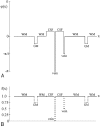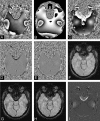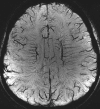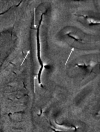Susceptibility-weighted imaging: technical aspects and clinical applications, part 1
- PMID: 19039041
- PMCID: PMC3805391
- DOI: 10.3174/ajnr.A1400
Susceptibility-weighted imaging: technical aspects and clinical applications, part 1
Abstract
Susceptibility-weighted imaging (SWI) is a new neuroimaging technique, which uses tissue magnetic susceptibility differences to generate a unique contrast, different from that of spin density, T1, T2, and T2*. In this review (the first of 2 parts), we present the technical background for SWI. We discuss the concept of gradient-echo images and how we can measure local changes in susceptibility. Armed with this material, we introduce the steps required to transform the original magnitude and phase images into SWI data. The use of SWI filtered phase as a means to visualize and potentially quantify iron in the brain is presented. Advice for the correct interpretation of SWI data is discussed, and a set of recommended sequence parameters for different field strengths is given.
Figures












References
-
- Reichenbach JR, Venkatesan R, Schillinger DJ, et al. Small vessels in the human brain: MR venography with deoxyhemoglobin as an intrinsic contrast agent. Radiology 1997;204:272–77 - PubMed
-
- Baudendistel KT, Reichenbach JR, Metzner R, et al. Comparison of functional MR-venography and EPI-BOLD fMRI at 1.5 T. Magn Reson Imaging 1998;16:989–91 - PubMed
-
- Reichenbach JR, Essig M, Haacke EM, et al. High-resolution venography of the brain using magnetic resonance imaging. MAGMA 1998;6:62–69 - PubMed
-
- Essig M, Reichenbach JR, Schad LR, et al. High-resolution MR venography of cerebral arteriovenous malformations. Magn Reson Imaging 1999;17:1417–25 - PubMed
-
- Lee BC, Kuppusamy K, Grueneich R, et al. Hemispheric language dominance in children demonstrated by functional magnetic resonance imaging. J Child Neurol 1999;14:78–82 - PubMed
Publication types
MeSH terms
Substances
Grants and funding
LinkOut - more resources
Full Text Sources
Other Literature Sources
Medical
